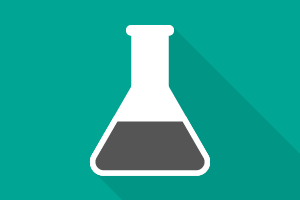Classroom Resources: Electrochemistry
Filter by:
1 – 18 of 18 Classroom Resources
-

Activity Series, Electrons, Electrons, Electron Transfer, Atoms, Ions, Chemical Change | High School
Activity: Game Activity: Activity Series Game Mark as Favorite (1 Favorite)
In this game, students will explore the activity series of metals by observing interactions between metals and metal ions. The game starts with a brief tutorial followed by a “capture the flag” game where students “steal” electrons based on the activity series. Then students play a pong-style game based on reactivity to earn points. Finally, there are two extension activities for students to view videos of real-world reactions and create particle models of these reactions.
-

Activity Series, Electron Transfer, Electrons | High School
Game: Activity Series Game Mark as Favorite (7 Favorites)
In this game, students will explore the activity series of metals by pitting pairs of metals and metal ions against one another and observing which one steals electrons from the other. Students can play "capture the flag" and a pong-style game where they use ions as the ball. Two extension activities have students view videos of real-world reactions and create a particulate model of what they observed.
-

Activity Series, Redox Reaction, Half Reactions, Oxidation, Reduction, Chemical Change, Predicting Products | High School
Lab: The Corrosion of Iron Mark as Favorite (12 Favorites)
In this lab, students will investigate the process of corrosion, a redox reaction, by analyzing how iron nails react in varied environments. Students will combine their prior knowledge with research about the reactivity of metals to make predictions in advance of the lab investigation.
-

Classification of Reactions, Redox Reaction, Activity Series, Oxidation, Reduction | High School
Lab: Investigating Oxidation-Reduction Reactions Mark as Favorite (16 Favorites)
In this lab, students will observe, classify and predict the products of single replacement, combination and decomposition reactions and provide a rationale for how reactions are classified using evidence from the lab and classroom.
-

Activity Series, Electrons, Electron Transfer, Balancing Equations, Predicting Products, Chemical Change, Chemical Change, Observations | High School
Activity: Simulation Activity: Metals in Aqueous Solutions Mark as Favorite (12 Favorites)
In this activity, students will run simulated tests of various metals in aqueous solutions to determine the relative reactivity of these metals. A total of eight metals will be observed in various combinations with the corresponding metal nitrate solutions and hydrochloric acid. Students will interpret the data collected to construct an activity series of the elements used in this simulation.
-

Activity Series, Chemical Change, Electrons, Electron Transfer, Balancing Equations, Chemical Change, Predicting Products, Observations, Acid Base Reactions | High School
Simulation: Metals In Aqueous Solutions Mark as Favorite (109 Favorites)
In this activity, students will run simulated tests of various metals in aqueous solutions to determine the relative reactivity of these metals. A total of eight metals will be observed in various combinations with the corresponding metal nitrate solutions and hydrochloric acid. Students will interpret the data collected to construct an activity series of the elements used in this simulation.
-

Activity Series, Balancing Equations, Predicting Products, Chemical Change, Chemical Change, Observations | High School
Lab: Activity Series of Unknown Metals Mark as Favorite (40 Favorites)
In this lab, students will create an activity series of metals from a series of reactions involving unknown metals. They will then compare their activity series and a list of metals used in this lab (supplied by the teacher after data collection) to a published activity series to identify the unknown metals.
-

Predicting Products, Activity Series, Chemical Change, Chemical Change, Observations | High School
Project: Wastewater Recovery Mark as Favorite (72 Favorites)
In this project, students will analyze test results in order to design a procedure for recovering certain metals from wastewater using their knowledge of the Activity Series of Metals and single replacement reactions. Based on their analysis, students will create a proposal for presentation in an effort to recommend the best plan for reclaiming the metals from the wastewater.
-

Chemical Change, Activity Series, Redox Reaction, Chemical Change, Physical Change | High School
Demonstration: Understanding the Discrepant Reactivity of Copper in the Presence of Strong Acids Mark as Favorite (8 Favorites)
In this demonstration, students practice their observation skills during the additions of different acids to two test tubes containing copper. The activity is structured to allow students to make thoughtful remarks about what they observe, using rich indicators of both chemical and physical properties and changes. In subsequent lessons on new concepts, students can reflect back on their observations to rationalize the discrepant results of the reactions in the demonstration.
-

Classification of Reactions, Balancing Equations, Solubility Rules, Activity Series, Predicting Products | High School
Simulation: Predicting Products Mark as Favorite (136 Favorites)
In this simulation, students will reference an activity series and a solubility chart to accurately predict the products of single replacement and double replacement chemical reactions. Associated particle diagrams will be displayed to help students better comprehend the reaction at the particulate level. Students will also be asked to balance the chemical equation. The simulation is designed as a five question quiz for students to use multiple times.
-

Classification of Reactions, Balancing Equations, Solubility Rules, Activity Series, Predicting Products | High School
Activity: Simulation Activity: Predicting Products Mark as Favorite (64 Favorites)
In this simulation, students will reference an activity series and a solubility chart to accurately predict the products of single replacement and double replacement chemical reactions. Associated particle diagrams will be displayed to help students better comprehend the reaction at the particulate level. Students will also be asked to balance the chemical equation. The simulation is designed as a five question quiz for students to use multiple times.
-

Activity Series, Chemical Change, Redox Reaction, Reduction, Oxidation, Balancing Equations | High School
Lesson Plan: Single Displacement Reactions with Test Tube Diagrams Mark as Favorite (65 Favorites)
In this lesson students will perform and analyze two single displacement reactions and prepare and manipulate Test Tube Diagrams to depict the activity at the molecular level. Using manipulatives representing individual ions, atoms and molecules for the various reactants and products, they will accurately represent species in the solid, gaseous and aqueous states by correlating the Test Tube Diagram to the complete ionic equation for each reaction. They will determine the reactants and products responsible for color, as well as identify which species is oxidized and which is reduced.
-

Activity Series, Classification of Reactions, Chemical Change | High School
Lab: Investigating the Activity Series of Metals Mark as Favorite (62 Favorites)
In this lab, students will create an activity series of metals and predict whether or not single replacement reactions are likely to occur.
-

Activity Series, Chemical Change, Oxidation, Reduction, Net Ionic Equation, Redox Reaction, Observations | High School
Lab: Fine Art of Redox Mark as Favorite (24 Favorites)
In this lab, students will practice writing and balancing redox reactions and use the activity series to verify the outcome of a chemical reaction.
-

Atomic Spectra, Activity Series, Emission Spectrum, Ions, Electromagnetic Spectrum, Emission Spectrum, Observations, Inferences | High School
Lab: Flame Test: Going Further Mark as Favorite (58 Favorites)
In this lab, students will investigate the colors produced when several mixtures of metallic ions are placed in a flame.
-

Classification of Reactions, Oxidation, Reduction, Percent Yield, Stoichiometry, Chemical Change, Redox Reaction, Activity Series, Error Analysis, Dimensional Analysis, Mole Concept, Measurements | High School
Lab: Extracting Copper From Ore Mark as Favorite (16 Favorites)
In this lab, students extract copper from copper carbonate using two different methods, and then determine which industrial method is most effective.
-

Activity Series, Oxidation, Reduction, Redox Reaction, Electricity, Electrons, Electron Transfer, Reduction Potentials | High School
Lab: Reactivity & Electrochemistry Mark as Favorite (12 Favorites)
In this lab, students will relate cell potential to the activity series.
-

Chemical Change, Activity Series, Redox Reaction, Electrons, Electron Transfer, Reduction, Oxidation, Half Reactions, Galvanic Cells, Observations, Chemical Change | High School
Lesson Plan: Exploring Automotive Corrosion Mark as Favorite (10 Favorites)
In this lesson students will investigate the galvanic corrosion that can occur when different metals come in contact with each other in modern cars.